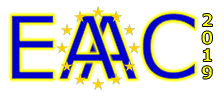Speaker
Description
Pre-plasma dynamics on the front side of a target foil in a laser-ion-acceleration process like Target-Normal-Sheath-Acceleration (TNSA) substantially influences the dynamics of the actual Debye-sheath formation and therefore eventually ion yield or ion energies. Acceleration dynamics on sub-picosecond timescales in the laser field are extremely challenging to probe experimentally. Therefore, Particle-In-Cell (PIC) simulations are used to investigate underlying processes, with accurate pre-plasma conditions being a necessary input for a realistic simulation. We realized an optical pre-plasma probing setup based on the well-known interferometric phase-measurement method to extensively study pre-plasma conditions and compare these results to the 1D hydrodynamics code MULTI-fs. Our setup produces laser-induced plasma from a $4\cdot 10^{15}\,\mathrm{Wcm}^{-2}$ pump-laser with properties otherwise similar to the petawatt-class POLARIS laser main beam and can be operated with pulse repetition rates of $1\,\mathrm{Hz}$. The probe pulse of $130\,\mathrm{fs}$ duration can probe the plasma conditions starting at $20\,\mathrm{ps}$ up to $2\,\mathrm{ns}$ after the interaction. In a first experiment, we varied key parameters including angle of incidence, pump polarization and pump intensity. Our results show a wide range of influences to plasma formation and shape and allow the investigation of a simple model bringing MULTI-fs simulation and experiment to very good agreement.

